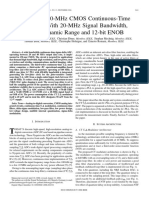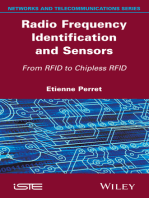8192 Channel Grating Light Valve For Ultra Violet Direct Write Lithography
8192 Channel Grating Light Valve For Ultra Violet Direct Write Lithography
Uploaded by
Umar BadshahCopyright:
Available Formats
8192 Channel Grating Light Valve For Ultra Violet Direct Write Lithography
8192 Channel Grating Light Valve For Ultra Violet Direct Write Lithography
Uploaded by
Umar BadshahOriginal Title
Copyright
Available Formats
Share this document
Did you find this document useful?
Is this content inappropriate?
Copyright:
Available Formats
8192 Channel Grating Light Valve For Ultra Violet Direct Write Lithography
8192 Channel Grating Light Valve For Ultra Violet Direct Write Lithography
Uploaded by
Umar BadshahCopyright:
Available Formats
An 8192-Channel Grating
Light Valve for Ultra-
Violet Direct-Write
Lithography
© 2015 Silicon Light Machines
An 8192-Channel Grating Light Valve for Ultra-Violet Direct-Write Lithography
Introduction
Silicon Light Macines has developed a new 8192-channel spatial light modulator for
ultra-violet direct imaging (“UVDI”). Based on Grating Light ValveTM (GLV) technology,
the modulator provides high-resolution control of laser intensity and edge timing at
operating wavelengths ranging from 350-410nm. Analog intensity control is supported
through 10-bit amplitude levels, and edge timing control is supported by 8-bit digital
delay. The module supports variable line-refresh rates between 50 and 250 kHz. By
combining the high intrinsic speed of the Grating Light Valve together with precise
amplitude and delay control electronics, a module with with unparalleled capability has
been realized. This enables control of printed features at sub-grid resolutions well below
the minimum printed feature size, effectively delivering higher resolution without
compromising throughput. Used in conjunction with line-shaped illumination, the module
has been field qualified for 10,000 hour lifetime at peak power densities of up to
3200W/cm2.
Figure 1. 8192-Channel Ultra-Violet Direct Imaging (UVDI) module
Parameter Value Units
Pixel count 8192 pixels
Operating wavelength 350-410 nm
Optical efficiency (0-order) 80 %
Contrast ratio (0-order) 300 -
Amplitude resolution 10 bits
Delay resolution 8 bits
Optical rise & fall time < 200 ns
Optical damping time 800 ns
Column refresh rate 50 - 250 kHz
Data rate 12.7 Gbps
Power disspation 45 W
Peak power density 3200 W/cm 2
Table 1. Principal specifications for 8192-channel UVDI module
www.siliconlight.com © 2015 Silicon Light Machines Page 2 of 14
An 8192-Channel Grating Light Valve for Ultra-Violet Direct-Write Lithography
Intensity or Voltage
d1 d2 d3 d4 A4
A2
A3
A1
Column strobe
Delay clock
Figure 2: Schematic of amplitude & delay functionality of UVDI modulator. Each
channel supports programmable 10-bit analog amplitude (Ai) and 8-bit digital
delay (Di), controlled by system inputs column strobe pcs and delay clock wclk.
Figure 2 schematically illustrates the amplitude and timing control embodied in each
pixel of the UVDI modulator. The blue line can represent either drive voltage or optical
intensity. External timing inputs are column strobe (pcs) and delay clock (wclk). These
signals are generated on the lithography tool and represent the physical speed of the
stage. Column strobe pcs divides elapsed time into discrete time periods or columns. A
typical column period is 4us (250 kHz). Delay clock wclk is a higher-frequency signal
used in conjunction with the programmable delay function to provide fine control of
control of transition timing.
As shown in Figure 2, a single optical transition can occur within one column period
(provided the amplitude value changes between columns). An 8-bit digital delay value
instructs when the amplitude update occurs within the column period. A digital counter
in each channel counts elapsed wclk cycles since the last column strobe. A comparator
in each channel compares this against a programmed digital delay value (0-255) and
executes the amplitude update when a match is detected. For maximum resolution, the
the wclk period would be 1/(28)=1/256 of the column period. In practice, the number of
wclk periods is typcially set to a lower value such as 200-240. Unique amplitude and
delay values can be updated for all pixels independently and at every column period.
But what is the utility of a programmable delay function? Most high-throughput direct-
write lithography systems operate with continuous media motion (as opposed to step
and expose mode). In continuous print systems, a high speed modulator equipped with
programmable delay can be used to achieve superior resolution as illustrated in Figure
3. Figure 3a shows a minimum feature printed on a grid pitch of the same dimension. In
this case, some features (such as the diagonal line shown) are not represented with
sufficient resolution. In contintous print systems using 2D spatial light modulators, this
can be ameliorated in by re-exposing the minimum feature at a sub-grid resolution finer
than the minimum feature (1/4 sub-grid shown in 3b). However, while this improves
resolution, it requries four times the number of individual exposures, thereby degrading
throughput. Figure 3c illustrates printing scheme used with in the UVDI module.
Programmable delay is used to place edges onto the sub-grid in the time time axis, and
the programmable amplitude of each pixel is used to place edges onto the sub-grid of
the orthogonal (pixel) axis. This allows the UVDI module to achieve sub-grid resolution
in a single pass. Note that the number of pixels assigned to a minimum feature is
completely variable. Depending on contrast and resolution requirement, one, two, three
or more contiguous GLV pixels can be ganged to define the minimum feature. Since the
www.siliconlight.com © 2015 Silicon Light Machines Page 3 of 14
An 8192-Channel Grating Light Valve for Ultra-Violet Direct-Write Lithography
minimum feature is not tied to the structure of the GLV, it can be displaced arbitrarily at
the resolution of the GLV pixel pitch.
Figure 3: Linear printing with spatial light modulator. (a) Minimum features
printed without sub-grid delivers insufficient resolution for some patterns. (b) Re-
exposing on sub-grid enhances spatial resolution, but degrades throughput. (c)
UVDI uses programmable delay to achieve sub-grid resolution in a single pass.
The objective of this white paper is to introduce the operating principle and capabilities of
the 8192-channel GLV modulator. We begin with a descrition of the GLV modulator
including a review of the custom hybrid CMOS/MEMS process developed to enable this
technology. Next we discuss the design & operation of the CMOS channel driver
associated with each pixel. We then introduce the module-level electronic hardware
supporting the GLV including deserializers, field programmable gate arrays (FPGAs),
digital-to-analog converters (DACs), and programmable system-on-a-chip (PSoC)
microcontroller. We briefly outline the data interface and discuss module firmware.
Finally, examples of optical performance are presented, including direct-write lithography
results of printed images in photo-resist.
GLV Spatial Light Modulator
The high channel-count of the 8192-channel light modulator posed a challenge in
balancing pixel width against device size. Smaller pixels facilitate smaller chips which
are easier to manufacture and require less de-magnification in the lithography tool,
allowing smaller, lower-cost lens systems. However, smaller modulator pixels are more
difficult to design, since all CMOS circuitry must fit within a narrower channel width. The
UVDI device strikes a balance between these competing factors, adopting a 5um pixel
width for an overall chip dimension of 43 x 10mm as shown in Figure 4. To enhance
uniformity, the 8192-channel modulator is broken into 32 identical blocks of 256
channels each (lower right inset of Figure 4). Each block operates as a stand-alone
chip, with independent inputs signals, clocks, supply voltages and grounds. Blocks
along the left side of the chip drive even-numbered pixels, and blocks on the right drive
odd-numbered pixels. Although the drive channels are segmented into blocks, no such
grouping occurs for the GLV MEMS array: pixels from the left- and right-hand blocks are
interlaced into an unbroken array of 8192 pixels in the GLV ribbon area.
www.siliconlight.com © 2015 Silicon Light Machines Page 4 of 14
An 8192-Channel Grating Light Valve for Ultra-Violet Direct-Write Lithography
As shown in the upper right of Figure 4, each pixel is composed of one moving ribbon
and one static “gap,” both 2.5um wide. This design maximizes 0th order efficiency and
contrast. Array reflectivity is roughly ~80% at 355nm. The ribbons are 150um long and
fabricated from amorphous stoichiometric LPCVD silicon nitride covered with a thin layer
of sputtered aluminum which serves both as electrical conductor and optical reflector.
Each ribbon is connected to the output of a dedicated CMOS driver channel.
Ch. 0
2.5um
Ribbon
Post Anchors Gap
2.5um
10mm
43 mm
256
Channel
Bond Pads
Block
GLV Ribbons
CMOS Drivers
J
Figure 4: Structure of 8192-channel spatial light modulator. Each pixel comprises
one ribbon and one gap each 2.5um wide (upper right). GLV modulator is
composed of 32 identical blocks of 256 channels each (lower right).
Figure 5a shows a close-up of the end of the GLV ribbon array. The end bars and
cross-marks are fiducial markings used for optical alignment of the GLV. Figure 5b
shows a close-up of interconnect from the CMOS drivers (top) to the GLV ribbons
(bottom). One set of ribbon fret posts (anchors) is visible at the bottom of the figure.
After dicing, the GLV devices are die-attached into a multi-layer ceramic package, as
shown in Figure 5c. Then nearly 800 wire-bond connections are made between the
perimeter die bond pads and plated lands on the surface of the ceramic substrate.
These wire-bonds are barely visible along the long axis of the die in Figure 5c. The
ceramic package mounts into a socket on the module. Spring loaded pins in the socket
contact lands on the bottom of the ceramic substrate to establish electrical connectivity
between the module and device. The package is secured in the socket by means of a
Kovar window-lid. The quartz window in this lid is anti-reflection coated and angled
slightly off normal to avoid glass reflections from degrading 0th order contrast.
www.siliconlight.com © 2015 Silicon Light Machines Page 5 of 14
An 8192-Channel Grating Light Valve for Ultra-Violet Direct-Write Lithography
www.siliconlight.com © 2015 Silicon Light Machines Page 6 of 14
An 8192-Channel Grating Light Valve for Ultra-Violet Direct-Write Lithography
occurs and the 0th-order light is back reflected. By applying intermediate voltages, light
can be continuously re-distributed between the 0th and ±1st-order modes, allowing gray-
scale intensity control between bright and dark states.
180° 0°
Ribbon
7λ 6λ
4 4
Substrate
Dark State Bright State
Figure 6: Cross-section through GLV ribbon array. Gap thickness in quiescent
state is arranged for destructive interference between light reflected from ribbon
and substrate regions (dark state, left). By deflecting ribbons one quarter
wavelength, constructive interference results (bright state, right).
Figure 7: 0th-order 355nm IV curve for UV modulator (red curve). Yellow shows the
adjusted voltage range of CMOS driver. By limiting driver voltage from just below
dark rollover to just above bright rollover, highest amplitude resolution is
achieved. Differential curve (blue) shown by a maximum of <0.3%-per-DAC.
Figure 7 shows the intensity-voltage (IV) curve for 355nm illumination. The red curve is
the 0th order optical response. The yellow curve shows the adjusted voltage range
www.siliconlight.com © 2015 Silicon Light Machines Page 7 of 14
An 8192-Channel Grating Light Valve for Ultra-Violet Direct-Write Lithography
swept out by the channel driver. By limiting driver output voltage from just below dark
rollover to just above bright rollover, highest amplitude resolution is achieved. The 8192-
channel module allows a broad range of voltage adjustment, including (a) maximum
drive voltage, (b) voltage swing range and (c) offset voltage, implemented by
programmable control of the common plane potential (including negative voltages). The
last item is valuable in preserving amplitude resolution with IV curves where the bright or
dark rollover occurs at a voltage significantly different from zero (as is the case for
355nm illumination). The blue line in Figure 7 reports the differential-intensity-gain or
“DIG.” DIG represents the slope of the optical response, measured in %-reflectance
change per amplitude DAC increment. As can be seen from the plot, the maximum DIG
occurs at the inflection point of the IV-curve. The design target for this device was
maximum DIG of < 0.3%-per-DAC at 355nm. As shown in Figure 7, this goal is
achieved.
CMOS/MEMS Integration: iGLV
Historically, GLV modulators have been passive MEMS devices connected to CMOS
drive chips by wire-bond arrays (i.e. multi-chip modules). However, for the 8192-channel
device this approach was not practical due to the large area which would be required for
wire-bond pads. Instead, we took the approach of integrating the CMOS driver and
MEMS together on the same chip. This required merging Silicon Light Machines’ GLV
flow with a compatible CMOS process. We chose to integrate with the SmartMOS7 flow
from Freescale Semiconductor. The resulting CMOS/MEMS hybrid process flow is
called “iGLV,” in which the “i” designates “integrated.” The architecture of the iGLV flow
is largely dictated by the thermal hierarchy of the constituent process modules. Highest
temperature modules occur first, followed by successively lower temperature modules:
i.e., (i) transistors, (ii) MEMS, (iii) interconnect and (iv) release. Highlights of the iGLV
process are listed below.
• 0.35um CMOS with high voltage NMOS (40V)
• Three metal layers (AlCu) with refractory liners
• Titanium-nitride local interconnect for lower electrode on GLV
• Low-resistance silicided poly-silicon (3Ω/square)
• High resistance poly-silicon (6.7kΩ/square)
• Tungsten plug contacts with silicide interface
• Isolated P- and N-wells
• Poly-poly capacitors
www.siliconlight.com © 2015 Silicon Light Machines Page 8 of 14
An 8192-Channel Grating Light Valve for Ultra-Violet Direct-Write Lithography
Module Electronics
In addition to the GLV, the UVDI module incorporates a variety of support electronics
needed to configure and drive the device. A functional block diagram of the module is
shown in Figure 8. The major subsystems comprising the UVDI module are: (a) low-
voltage differential signalling (LVDS) deserializers, (b) field programmable gate arrays
(FPGAs), (c) digital-to-analog converters (DACs), (d) programmable system-on-a-chip
(PSoC) microcontroller, and (e) power supplies.
Down-Link Amp
LVDS 48 FPGA DAC
Delay
256 Ch.
Deserializer Block
LVDS 8
•••
Channels Error Check
Amp
Up-Link DAC 256 Ch.
Look-Up Tables Delay Block
Colum Strobe
•••
& Delay Clock
DAC Amp
256 Ch.
Up-Link FPGA Delay Block
•••
Down-Link Error Check
48 Amp
LVDS DAC 256 Ch.
Deserializer Look-Up Tables Delay Block
LVDS 8
Channels
Health Voltages for
GLV
PSoC monitoring GLV
(32 blocks)
Figure 8: Block diagram of module electronics. Major subsystems include (a)
LVDS deserializers, (b) FPGAs, (c) high-speed DACs, (d) programmable system-
on-a chip micro-controller (PSoC) and (e) voltage supplies for GLV.
Starting on the left of Figure 8, communication from controller board to the GLV occurs
over a “down-link” interface composed of 16 high-speed LVDS serial channels each
operating at a maximum of 798 Mbps. Down-link data is received and deserialized at
the module by means of two DS90CR486 National Semiconductor Channel-Link ICs.
These convert the 16 high-speed LVDS serial lines into two 48-bit parallel digital buses
operating at a maximum of 133 MHz. The resulting maximum data throughput for the
module is 12.768 Gbps.
After deserialization, data flows into two Altera Cyclone II FPGAs which decode, error-
check and buffer the data. For any given column, the image data is written to one of two
pixel data registers (PDRs). This dual buffer architecture allows image data from the
current column to be written to one PDR while image data from the previous column is
being read from the other PDR (in Ping-Pong fashion).
www.siliconlight.com © 2015 Silicon Light Machines Page 9 of 14
An 8192-Channel Grating Light Valve for Ultra-Violet Direct-Write Lithography
While the UVDI module supports “physical” 10-bit amplitude and 8-bit delay resolutions,
the bandwidth required to transmit full resolution to the module at run-time would limit
the maximum column rate. Instead, the 8192-channel modulator employs “logical”
values configured prior to run-time. This offers the advantage of faster column rates
without compromising resolution. For example, one firmware embodiment provides
seven logical 10-bit amplitudes and eight logical 8-bit delays. Each of these can be
represented by a 3-bit descriptor, resulting in a 67% overall data rate savings (since
(3+3)/(10+8) = 0.33). In Figure 8, each of the two 48 bit buses from the deserializers
comprises 8 channels of 6 bits each (3 amplitude bits and 3 delay bits). Back-
conversion from the 3-bit amplitude & 3-bit delay data to the full 10-bit amplitude & 8-bit
delay occurs in real time through “logical-to-physical” look-up-tables (LUTs) in the FPGA,
before the data is sent to the GLV.
The primary outputs of the FPGAs are digital signals that (a) drive the amplitude DACs
and (b) drive the 4-bit DDR delay busses. The 8192-channel module uses a single
differential amplitude DAC and a single 4-bit DDR delay bus for each of the thirty-two
256-channel blocks on the GLV. In addition to these outputs, the FPGAs also support a
LVDS communication output or “up-link” which allows table and register data to read
from FPGAs. Up-link replies are sent in response to a coded “read” command
transmitted over the down-link. In summary, the FPGAs perform a variety of
manipulation and formatting operations on the data before passing it to the GLV,
including:
.
• Interfacing with LVDS deserializers
• Decoding, error checking & buffering image data
• Logical-to-physical look-up-tables for amplitude & delays
• Driving DACs for GLV amplitude path
• Driving digital delay busses for GLV delay path
• Uplink and timing interface
Finally, the 8192-channel UV modulator is also equipped with a programmable system-
on-a-chip (PSoC) microcontroller for system management and health monitoring. The
Cypress Semiconductor PSoC contains an 8-bit microcontroller, EEPROM non-volatile
memory, programmable digital logic and programmable analog circuits. The PSoC
responds to commands from the host controller board by means of an I2C
communication interface and interacts with other module components (like FPGAs and
temperatures sensor) by means of an SPI interface. Supported I2C commands from the
controller include: (a) module power-up & power-down, (b) automatic de-skew of LVDS
deserializers, (c) reset of FPGAs, (d) control of amplitude DAC operating voltage range,
(e) monitoring of module voltages & currents, and (f) reading & writing to non-volatile
EEPROM memory.
Power is supplied to the 8192-channel modulator by means of a single 24V input line
from the controller board. All internal supply voltages (10 in total) are generated from
the input source using a combination of DC-to-DC converters and linear regulators for
noise suppression. Each voltage generation circuit has an enable function controlled by
the PSoC for power-up and power-down sequencing. Typical current draw on the 24V
supply line is 1.8A corresponding to a total power consumption of 45W.
www.siliconlight.com © 2015 Silicon Light Machines Page 10 of 14
An 8192-Channel Grating Light Valve for Ultra-Violet Direct-Write Lithography
Optical Performance
We next present optical performance highlights from a UVDI module. Figure 9 shows a
“line-scan” of a 8192-channel modulator. This plot was generated by scanning a
focused CW 405nm laser along the length of the GLV array under various static ribbon
configurations. The width of the scanning spot is approximately 7um (full width, 1/e2).
The blue and yellow traces show the bright and dark array states respectively. Two sets
of “comb” traces C1-C4 are also shown. In the comb traces, every 4th pixel is activated
(either to bright or dark state) while the neighboring ribbons are held in the
complementary state. This is repeated for modulo 0, 1, 2, and 3 pixels to generate the
quadrature profiles shown in the inset to left in Figure 9.
Figure 9: Line-scan along 8192-GLV array measured at 405nm. All pixel on bright
trace (yellow) and all pixel off dark grace (blue) are shown along with “comb”
scans C1-C4 in which every 4th pixel is activated.
Figure 10 illustrates the dynamic properties of the GLV. Figure 10a show the optical
“ring-down” curve, generated by driving a single pixel with a short voltage pulse and then
allowing it to freely settle in absence of electrical drive. The ring-down curve is least-
squares fit to extract the resonant frequency and damping time. Damping time refers to
time required for the oscillations to reduce by a factor of 1/e. Resonant frequency for the
UVDI device is typically 1.2 MHz and damping time is approximately 800ns. Figure 10b
shows resonance and damping as a function of position along the array. In this case the
variation in resonant frequency is < 2%. Figure 10c shows a full-scale optical pulse
profile (405nm). The 10%-90% rise and fall times are extracted from the pulse profile.
As shown, rise/fall times are typically < 200ns for the UVDI device. Figure 10d shows
rise/fall time as a function of position along the array
Figure 11 illustrates the delay capability of the UVDI module. Figure 11a shows a
“delay-sweep”. The red curve was generated by sweeping the programmed delay of a
single pixel from 0-200 at the minimum delay increment (20ns) and the measuring the
position of the pulse edge. As shown in the plot, linearity of the delay response is
excellent. Moreover, the delay is extremely uniform across the 8192 channels as a
result of the digital delay architecture (delay uniformity typically < 80ns). The yellow dots
in Figure 11a indicate selected delay settings illustrated in the pulse profiles shown in
Figure 11b. Here we can see that the falling edge of the pulse can be programmatically
www.siliconlight.com © 2015 Silicon Light Machines Page 11 of 14
An 8192-Channel Grating Light Valve for Ultra-Violet Direct-Write Lithography
adjusted over the column period. Alternate delay settings can be used to sweep the
rising edge in a similar way.
a. b.
c. d.
Figure 10: (a) Free oscillation “ring-down” response of GLV ribbon. Data is fit to
determine resonant frequency and damping time. (b) Plot of resonance and
damping across device. (c) Full-scale bright-dark pulse used to extract 10%-90%
rise and fall times. (d) Rise-fall times vs. pixel measured across device.
a. b.
20ns per
delay
increment
Figure 11: (a) Delay-sweep (red curve) generated by incrementing programmed
delay by 20ns and measuring pulse edge position. Yellow dots indicated delay
values illustrated in 13b. (b) Pulse profiles in which falling edge position is swept
over the column period with arbitrary resolution.
www.siliconlight.com © 2015 Silicon Light Machines Page 12 of 14
An 8192-Channel Grating Light Valve for Ultra-Violet Direct-Write Lithography
Application to Lithography
Finally, we present direct write lithography results illustrating photo-resist images printed
with the UVDI module. Recall from Figure 3c, that the print methodology employed with
the UVDI module is to place a minimum feature on a sub-grid having higher resolution
than the minimum feature size (MFS) itself. For example, in Figure 3c the sub-grid
resolution is 1/4th of the minimum feature size.
Figure 12a shows 1.5 um vertical lines and spaces printed using 3-pixel minimum
feature size at the GLV. Complementary horizontal lines and spaces were created using
the programmable delay capability. By using the high resolution in edge timing, it is
possible to equalize the horizontal and vertical line widths to a high degree of precision.
This image was printed with 355nm illumination on i-line resist at media speed of
500mm/s using 10:1 demagnification.
Figure 12b shows 2.5 um vertical lines and spaces printed using 5-pixel minimum
feature size along the GLV array axis. Again, the horizontal lines were printed by using
programmable delay. While Figure 12a shows binary resist image (exposed vs. non-
exposed), 14b shows a tri-level printed pattern. Analog amplitude control was used to
partially expose the resist, appearing as the grey region between the unexposed and
fully exposed regions. The capability to “half-tone” expose resist is an area of growing
interest in photo-lithography for advanced manufacturing. This analog capability sets the
UVDI module apart from other spatial light modulators capable of binary exposures.
a. 1.5um line & space b. 2.5um with half-tone
Figure 12: Direct-write images printed with UVDI module. (a) 1.5 um lines and
spaces using 3-pixel minimum feature size. (b) 2.5um lines & spaces using a 5-
pixel minimum feature. Analog gray scale used to partially expose the resist (half
toning). Both images printed with 355nm illumination on i-line resist at 500mm/s
with 10:1 demagnification.
Figure 13a shows the DW3000 direct-write lithography tool produced by DNS
Electronics. This tool uses two 8192-channel GLV modules and is capable of printing
200 & 300mm wafers with 3um line-space resolution at throughputs of up to 65 wafers
per hour. Designed for advanced packaging applications, the DW3000 allows localized
control of image data to correct for warping and non-linear distortion data on a per wafer
basis. Overlay capability of the DW3000 is ±1um 3-sigma. Figure 13b highlights the
www.siliconlight.com © 2015 Silicon Light Machines Page 13 of 14
An 8192-Channel Grating Light Valve for Ultra-Violet Direct-Write Lithography
direct-write capability of the tool by printing a globally non-periodic, high resolution city
map of Kyoto. Under microscope inspection, individual houses and streets are visible on
this map.
a. b.
Figure 13: (a) DW3000 tool from by DNS Electronics for advanced packaging
direct-write lithography. Tool is capable processing 65 wafers per hour with 3um
line-space. (b) Global non-periodic pattern (Kyoto city map) printed onto 200mm
wafer with the DW3000. Individual houses are resolved on this map.
www.siliconlight.com © 2015 Silicon Light Machines Page 14 of 14
You might also like
- SAFe 5.0 QuizDocument47 pagesSAFe 5.0 Quizfran rNo ratings yet
- ZTT OPGW 21-116750 DatasheetDocument9 pagesZTT OPGW 21-116750 DatasheetMalik Shoaib khalidNo ratings yet
- Ultrasmall Digital Image Sensor For Endoscopic ApplicationsDocument4 pagesUltrasmall Digital Image Sensor For Endoscopic ApplicationsTaha OpedNo ratings yet
- Skyworks Bluetooth WhitepaperDocument14 pagesSkyworks Bluetooth Whitepaperrajkumar.araciontechNo ratings yet
- Csd97374Q4M Synchronous Buck Nexfet™ Power Stage: 1 Features 3 DescriptionDocument23 pagesCsd97374Q4M Synchronous Buck Nexfet™ Power Stage: 1 Features 3 DescriptionGabriel MenesesNo ratings yet
- 802.11a Baseband Core Product Brief: Features BenefitsDocument4 pages802.11a Baseband Core Product Brief: Features BenefitsLive After DeathNo ratings yet
- Ssdac G36 Pocket ManualDocument52 pagesSsdac G36 Pocket ManualKaushal AryaNo ratings yet
- OPGWDocument74 pagesOPGWAnonymous 3y4Z5cUNo ratings yet
- A Digital Envelope Modulator For A WLAN OFDM Polar Transmitter in 90 NM CMOSDocument8 pagesA Digital Envelope Modulator For A WLAN OFDM Polar Transmitter in 90 NM CMOSSaidatul IzyanieNo ratings yet
- DS131 Bridgelux EB Series Gen2 Data Sheet 20171020 Rev ADocument17 pagesDS131 Bridgelux EB Series Gen2 Data Sheet 20171020 Rev ADary Nur AhmadNo ratings yet
- Whitepaper - The Cable ChallengeDocument6 pagesWhitepaper - The Cable ChallengeJorge LlamasNo ratings yet
- Duobinary Coding For 10gbe: Abstract: We Propose A New Optical CodingDocument16 pagesDuobinary Coding For 10gbe: Abstract: We Propose A New Optical CodingsubhartiNo ratings yet
- RCML15 Series EncodersDocument2 pagesRCML15 Series Encoderssandeep naikNo ratings yet
- IJCRT2007590Document6 pagesIJCRT2007590Deepanshi R. KumarNo ratings yet
- Optical Fiber Communication Systems, Prepared By: Engr. S. CatolosDocument5 pagesOptical Fiber Communication Systems, Prepared By: Engr. S. CatolosGeremu TilahunNo ratings yet
- E14R00P51Document4 pagesE14R00P51andriotcircetNo ratings yet
- Implementing OFDM Using Altera Intellectual Property: White PaperDocument8 pagesImplementing OFDM Using Altera Intellectual Property: White PapernazishuqailiNo ratings yet
- Dell Networking mx8116n Spec SheetDocument3 pagesDell Networking mx8116n Spec SheetGS MeenaNo ratings yet
- CMOS Low Cost, 10-Bit Multiplying DAC AD7533: Features General DescriptionDocument12 pagesCMOS Low Cost, 10-Bit Multiplying DAC AD7533: Features General DescriptionccnbtNo ratings yet
- 300Mbps Wireless N PCI Adapter: TL-WN851NDDocument2 pages300Mbps Wireless N PCI Adapter: TL-WN851NDRiyan LesmanaNo ratings yet
- An Innovative Ultra Low Voltage Sub-32nm SRAM Voltage Sense Amplifier in DG-SOI TechnologyDocument4 pagesAn Innovative Ultra Low Voltage Sub-32nm SRAM Voltage Sense Amplifier in DG-SOI Technologyapi-19668941No ratings yet
- Data Sheet: AFBR-5803Z/5803TZ/5803AZ/5803ATZDocument16 pagesData Sheet: AFBR-5803Z/5803TZ/5803AZ/5803ATZgiba_cNo ratings yet
- Fiber Optic Ieee c37.94 g.703 E1 Multiplexer pdf2 133 PDFDocument18 pagesFiber Optic Ieee c37.94 g.703 E1 Multiplexer pdf2 133 PDFxvehicleNo ratings yet
- Q28QD080C0YF - QSFP28 Dual Fibre: 1310nm / 80km / 100GBASE-ZR4Document5 pagesQ28QD080C0YF - QSFP28 Dual Fibre: 1310nm / 80km / 100GBASE-ZR4Jose JaramilloNo ratings yet
- OM4 Fiber - The Next Generation of Multimode: Tony Irujo - Sales Engineer OFSDocument47 pagesOM4 Fiber - The Next Generation of Multimode: Tony Irujo - Sales Engineer OFSgryglewskiaNo ratings yet
- Controlling Servo Motors Using RF Module Transmitter and Receiver With ArduinoDocument12 pagesControlling Servo Motors Using RF Module Transmitter and Receiver With ArduinoJemimah Aniel ClimacoNo ratings yet
- Tyco ADC NetworkDocument28 pagesTyco ADC NetworkraneensysNo ratings yet
- Alxxf Mp400: Wireless Ethernet SolutionDocument2 pagesAlxxf Mp400: Wireless Ethernet SolutionpgrNo ratings yet
- Signal Loss High Speed High Frequency IpcDocument18 pagesSignal Loss High Speed High Frequency IpcrmcmillanNo ratings yet
- TI csd95372bq5mDocument13 pagesTI csd95372bq5mchassisdNo ratings yet
- Atmel 42131 RF Layout With Microstrip Application Note AT02865Document15 pagesAtmel 42131 RF Layout With Microstrip Application Note AT02865dwisselNo ratings yet
- 40G DP - (D) QPSK TXP 211650000-009 CID For Padtec Rev02 12102012Document14 pages40G DP - (D) QPSK TXP 211650000-009 CID For Padtec Rev02 12102012urielNo ratings yet
- Data Sheet: AFBR-5803AQZ and AFBR-5803ATQZDocument16 pagesData Sheet: AFBR-5803AQZ and AFBR-5803ATQZkelvinmanojNo ratings yet
- Nice RFDocument17 pagesNice RFmuhammadsubarkah3No ratings yet
- "Nano Simulator For Nano-Scale Mosfet" by Pragya Kushwaha, Panjab University (2009-2011)Document25 pages"Nano Simulator For Nano-Scale Mosfet" by Pragya Kushwaha, Panjab University (2009-2011)pragya18927710% (1)
- BCM5461S PBDocument2 pagesBCM5461S PBchassisdNo ratings yet
- Xgs 16Document14 pagesXgs 16alexmihai_scribdNo ratings yet
- Cambium Networks Data Sheet PMP 450i Subscriber ModuleDocument5 pagesCambium Networks Data Sheet PMP 450i Subscriber ModuleRahma Dewi MutiantiNo ratings yet
- Gpon 32Document14 pagesGpon 32Ye Htut WinNo ratings yet
- 16-Bit Delta-Sigma DAC With Cascade-Of-Resonators Feed-Forward Modulator and Interpolation Filter With OCSD CodeDocument4 pages16-Bit Delta-Sigma DAC With Cascade-Of-Resonators Feed-Forward Modulator and Interpolation Filter With OCSD Codealan3421407No ratings yet
- ATOM DX Data Sheet - ENDocument14 pagesATOM DX Data Sheet - ENFraesenfresseNo ratings yet
- An Introduction To Vlsi Processor Architecture For GaasDocument35 pagesAn Introduction To Vlsi Processor Architecture For GaasBibin JohnsonNo ratings yet
- Eds 408a PNDocument6 pagesEds 408a PNmarcosranesNo ratings yet
- Quantum Photonics 4 11Document22 pagesQuantum Photonics 4 11gogarry77No ratings yet
- Product Technical Data: 418Mhz Am Miniature Transmitter Module (Micro TX) Nv08JDocument4 pagesProduct Technical Data: 418Mhz Am Miniature Transmitter Module (Micro TX) Nv08Jinsomnium86No ratings yet
- E2v CCD 47-20Document13 pagesE2v CCD 47-20rauolNo ratings yet
- MicroESystems LDL C DataSheetDocument5 pagesMicroESystems LDL C DataSheetElectromateNo ratings yet
- Flat Corridor PanelDocument4 pagesFlat Corridor PaneldendincNo ratings yet
- Amplifier DesignDocument9 pagesAmplifier Designian neymarNo ratings yet
- I Type Medallion 6000Document6 pagesI Type Medallion 6000vicenteNo ratings yet
- Directional CouplersDocument18 pagesDirectional Couplerstejo murgiyantoNo ratings yet
- Otau-9150 v2 enDocument5 pagesOtau-9150 v2 ensrc jatNo ratings yet
- Network Essernet: 784766 FO Converter For Essernet, Single-ModeDocument1 pageNetwork Essernet: 784766 FO Converter For Essernet, Single-ModeVladimir BukaricaNo ratings yet
- Schneider Electric EcoStruxure-Panel-Server PAS800LDocument7 pagesSchneider Electric EcoStruxure-Panel-Server PAS800LdrissaNo ratings yet
- Marvell Automotive Ethernet 88q211x Product BriefDocument2 pagesMarvell Automotive Ethernet 88q211x Product BriefArun KumarNo ratings yet
- Maximizing The Capacity-Reach of 800G Generation Coherent: Baud Rates, Features, and Modem SNRDocument14 pagesMaximizing The Capacity-Reach of 800G Generation Coherent: Baud Rates, Features, and Modem SNRyunNo ratings yet
- Design and Implementation of High Gain, High Bandwidth CMOS Folded Cascode Operational Transconductance AmplifierDocument5 pagesDesign and Implementation of High Gain, High Bandwidth CMOS Folded Cascode Operational Transconductance AmplifierChristian Montano GalvezNo ratings yet
- Moxa Eds 408a Series Datasheet v1.4Document6 pagesMoxa Eds 408a Series Datasheet v1.4John DíazNo ratings yet
- Radio Frequency Identification and Sensors: From RFID to Chipless RFIDFrom EverandRadio Frequency Identification and Sensors: From RFID to Chipless RFIDNo ratings yet
- High-Performance D/A-Converters: Application to Digital TransceiversFrom EverandHigh-Performance D/A-Converters: Application to Digital TransceiversNo ratings yet
- Mohamad Johairie Mohamad Amin - Gov - Rev 1 - OptDocument6 pagesMohamad Johairie Mohamad Amin - Gov - Rev 1 - OptMohamad JohairieNo ratings yet
- Beam FormingDocument2 pagesBeam FormingVivek KesharwaniNo ratings yet
- Resume Khalish Farhan.Document1 pageResume Khalish Farhan.Khalish FarhanNo ratings yet
- C++ DSA Codes (Questions)Document5 pagesC++ DSA Codes (Questions)farman7757854No ratings yet
- Compare and Contrast Magnetic Tapes, Magnetic Disks, Optical Discs, Flash RAM, and Solid-State Drives (SSD) in Terms ofDocument2 pagesCompare and Contrast Magnetic Tapes, Magnetic Disks, Optical Discs, Flash RAM, and Solid-State Drives (SSD) in Terms ofstarlite564No ratings yet
- SN04Document4 pagesSN04Cherascu LiviuNo ratings yet
- Network Tools and Protocols Exercise 2: Emulating A Wide Area Network (WAN)Document4 pagesNetwork Tools and Protocols Exercise 2: Emulating A Wide Area Network (WAN)Fabio MenesesNo ratings yet
- ANACOVADocument3 pagesANACOVAPutu IndraNo ratings yet
- Online Shopping System Sequence Diagram PDFDocument3 pagesOnline Shopping System Sequence Diagram PDFpmasum472No ratings yet
- Autodock Vina 1.2.0: New Docking Methods, Expanded Force Field, and Python BindingsDocument8 pagesAutodock Vina 1.2.0: New Docking Methods, Expanded Force Field, and Python BindingsJoan Petit GrosNo ratings yet
- InheritanceDocument16 pagesInheritanceTybca077Goyani VaidehiNo ratings yet
- Office Relocation: Work Breakdown StructureDocument3 pagesOffice Relocation: Work Breakdown Structuresheilasch88No ratings yet
- 5th CSEDocument3 pages5th CSEJack SahuNo ratings yet
- Witness and CompanionsDocument12 pagesWitness and CompanionsChaebaiNo ratings yet
- Computer Science: Topic 2.2 - Programming TechniquesDocument5 pagesComputer Science: Topic 2.2 - Programming Techniquesnouse glNo ratings yet
- HazMap3D - DatasheetDocument2 pagesHazMap3D - DatasheetAngkik Pandu RNo ratings yet
- CAT 345 DL Hyd. SchematicsDocument13 pagesCAT 345 DL Hyd. SchematicsMoataz Sami100% (1)
- Ovation To Numalogic Fast Ethernet Remote Node CON - 040: For Use With Ovation 3.5.1, 3.5.2, and 3.6.0 Releases May 2016Document47 pagesOvation To Numalogic Fast Ethernet Remote Node CON - 040: For Use With Ovation 3.5.1, 3.5.2, and 3.6.0 Releases May 2016kumarNo ratings yet
- Ascon PhivDocument48 pagesAscon PhivSDK341431100% (1)
- Lesson Plan For Form 4Document5 pagesLesson Plan For Form 4Muthu Muhammad Nachiar50% (2)
- Monitoring Cultural Landscapes From Spac PDFDocument14 pagesMonitoring Cultural Landscapes From Spac PDFFvg Fvg Fvg100% (1)
- Assignment MOSDocument4 pagesAssignment MOSAnh KhoaNo ratings yet
- Les 02Document32 pagesLes 02Help DeskNo ratings yet
- QM - Lecture - 9 - 2023 (HW)Document28 pagesQM - Lecture - 9 - 2023 (HW)W MNGNo ratings yet
- Nota MEM160 PDFDocument146 pagesNota MEM160 PDFArefiq ShafikNo ratings yet
- 3351102Document7 pages3351102trivedi_urvi9087100% (1)
- HB 59-1994 Ergonomics - The Human Factor - A Practical Approach To Work Systems DesignDocument8 pagesHB 59-1994 Ergonomics - The Human Factor - A Practical Approach To Work Systems DesignSAI Global - APACNo ratings yet
- Retaining Wall PDFDocument10 pagesRetaining Wall PDFArnav Anuj Kasar100% (1)
- Saq 3.3 Cryptography & PkiDocument3 pagesSaq 3.3 Cryptography & PkiajitNo ratings yet

























































































